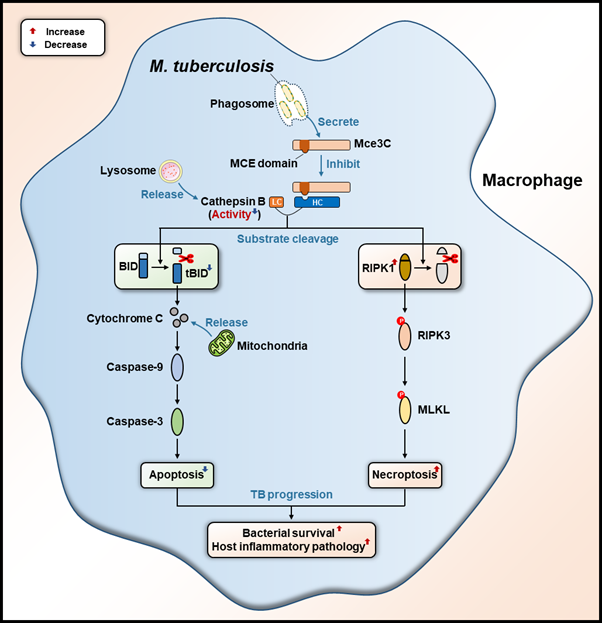Mammalian hosts coordinate various cell death pathways as part of the immune defense system against pathogens including Mycobacterium tuberculosis (Mtb), which causes tuberculosis featuring lung inflammation and necrosis. However, how Mtb manipulates host molecular switches of cell death pathways to reprogram cell death modalities and drive tuberculosis pathogenesis remain poorly understood.
Recently, Prof. LIU Cui Hua's group at the Institute of Microbiology of the Chinese Academy of Sciences (IMCAS) has revealed a pathogenic mechanism by which Mtb manipulates host lysosomal protease activity-depend plasticity between cell death pathways to promote its infection (Figure 1). This work was published in Proceedings of the National Academy of Sciences.
The researchers identified a Mtb effector protein, mammalian cell entry 3C (Mce3C), which promotes host cell necroptosis while inhibiting apoptosis. Mechanistically, Mtb Mce3C can bind host cathepsin B (CTSB), a lysosome-derived non-caspase protease that determines cell modalities. This binding inhibits CTSB’s protease activity towards BH3-interacting domain death agonist (BID) and receptor-interacting protein kinase 1 (RIPK1). Consequently, the production of pro-apoptotic truncated BID (tBID) is suppressed while the abundance of pro-necroptotic RIPK1 is maintained simultaneously. Using mouse infection models, the research team further demonstrated that disrupting the Mce3C-CTSB interface promotes host apoptosis while suppressing necroptosis, leading to attenuated Mtb survival and mitigated lung immunopathology.
This study identifies the key pathogenic effector protein that regulates the crosstalk between host cell death modalities during Mtb infection and provides a potential anti-tuberculosis strategy by targeting the Mce3C-CTSB interface to reduce the pathogenicity of Mtb.

Figure 1: Proposed model showing the mechanism by which Mtb Mce3C hijacks CTSB to remodel host cell death programs (image by Prof. LIU Cui Hua’s group)
Full text links:https://www.pnas.org/doi/10.1073/pnas.2406715122